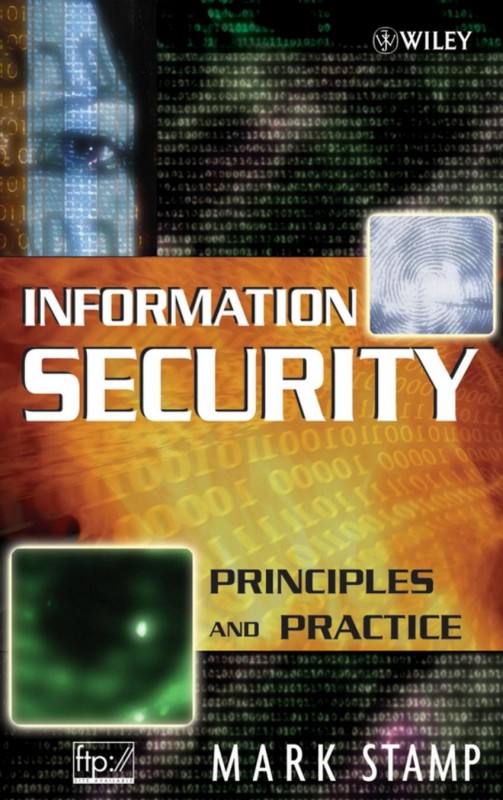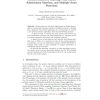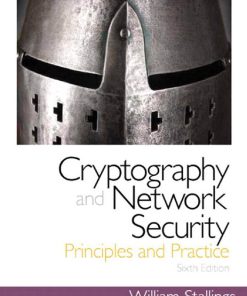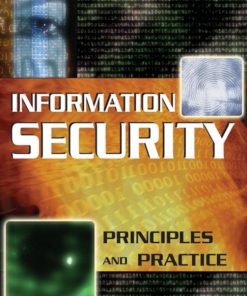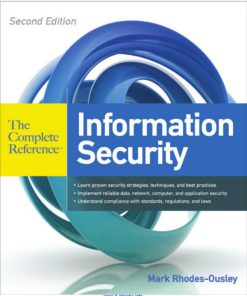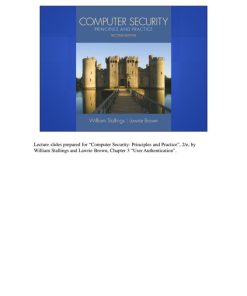Information Security Principles and Practice 1st Edition by Mark Stamp ISBN 0471738484 9780471738480
$50.00 Original price was: $50.00.$25.00Current price is: $25.00.
Authors:Mark Stamp , Series:IT & Computer [541] , Author sort:Stamp, Mark , Languages:Languages:eng , Published:Published:Nov 2005 , Publisher:Wiley
Information Security Principles and Practice 1st Edition by Mark Stamp – Ebook PDF Instant Download/Delivery. 0471738484, 978-0471738480
Full download Information Security Principles and Practice 1st Edition after payment
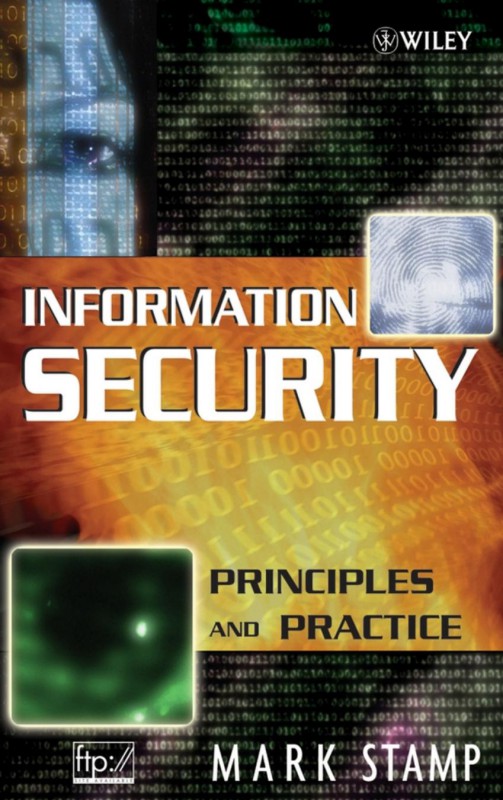
Product details:
ISBN 10: 0471738484
ISBN 13: 978-0471738480
Author: Mark Stamp
As businesses and consumers become more dependent on complex multinational information systems, the need to understand and devise sound information security systems has never been greater. This title takes a practical approach to information security by focusing on real-world examples. While not sidestepping the theory, the emphasis is on developing the skills and knowledge that security and information technology students and professionals need to face their challenges. The book is organized around four major themes:
* Cryptography: classic cryptosystems, symmetric key cryptography, public key cryptography, hash functions, random numbers, information hiding, and cryptanalysis
* Access control: authentication and authorization, password-based security, ACLs and capabilities, multilevel and multilateral security, covert channels and inference control, BLP and Biba’s models, firewalls, and intrusion detection systems
* Protocols: simple authentication protocols, session keys, perfect forward secrecy, timestamps, SSL, IPSec, Kerberos, and GSM
* Software: flaws and malware, buffer overflows, viruses and worms, software reverse engineering, digital rights management, secure software development, and operating systems security
Additional features include numerous figures and tables to illustrate and clarify complex topics, as well as problems-ranging from basic to challenging-to help readers apply their newly developed skills. A solutions manual and a set of classroom-tested PowerPoint(r) slides will assist instructors in their course development. Students and professors in information technology, computer science, and engineering, and professionals working in the field will find this reference most useful to solve their information security issues.
An Instructor’s Manual presenting detailed solutions to all the problems in the book is available from the Wiley editorial department.
An Instructor Support FTP site is also available.
Information Security Principles and Practice 1st Table of contents:
Chapter 1: Introduction to Information Security
- 1.1 What is Information Security?
- 1.2 The Importance of Information Security
- 1.3 Goals of Information Security
- 1.4 Confidentiality, Integrity, and Availability (CIA Triad)
- 1.5 Security Threats and Attacks
- 1.6 Overview of Information Security Principles
Chapter 2: Risk Management
- 2.1 Introduction to Risk Management
- 2.2 Identifying Risks in Information Systems
- 2.3 Assessing and Analyzing Risks
- 2.4 Risk Mitigation and Control Strategies
- 2.5 Risk Management Frameworks and Standards
- 2.6 Business Continuity Planning and Disaster Recovery
Chapter 3: Security Policies and Governance
- 3.1 Overview of Security Policies
- 3.2 Developing and Implementing Security Policies
- 3.3 Information Security Governance and Compliance
- 3.4 Legal and Regulatory Considerations in Security
- 3.5 Role of Information Security Officers (CISO)
- 3.6 Information Security Management Systems (ISMS)
Chapter 4: Cryptography
- 4.1 Introduction to Cryptography
- 4.2 Symmetric and Asymmetric Encryption
- 4.3 Cryptographic Hash Functions
- 4.4 Digital Signatures and Certificates
- 4.5 Public Key Infrastructure (PKI)
- 4.6 Key Management and Cryptographic Protocols
Chapter 5: Authentication and Access Control
- 5.1 Authentication Methods and Mechanisms
- 5.2 Password Management and Policies
- 5.3 Multi-Factor Authentication
- 5.4 Access Control Models (RBAC, MAC, DAC)
- 5.5 Identity and Access Management (IAM)
- 5.6 Single Sign-On (SSO) and Federation
Chapter 6: Network Security
- 6.1 Network Security Fundamentals
- 6.2 Firewalls and Intrusion Detection Systems (IDS)
- 6.3 Virtual Private Networks (VPNs)
- 6.4 Network Segmentation and Isolation
- 6.5 Securing Wireless Networks
- 6.6 Security in Network Protocols (IPSec, SSL/TLS, etc.)
Chapter 7: Security in Operating Systems
- 7.1 Operating System Security Models
- 7.2 Access Control and Privilege Management
- 7.3 Securing File Systems and Directories
- 7.4 Malware and Anti-Virus Protection
- 7.5 Patch Management and Vulnerability Assessment
- 7.6 Operating System Hardening
Chapter 8: Application Security
- 8.1 Software Development Life Cycle (SDLC) and Security
- 8.2 Secure Coding Practices
- 8.3 Common Vulnerabilities (e.g., SQL Injection, XSS)
- 8.4 Web Application Security
- 8.5 Secure Software Design and Testing
- 8.6 Security in Mobile and Cloud Applications
Chapter 9: Security Monitoring and Incident Response
- 9.1 Security Monitoring and Logging
- 9.2 Intrusion Detection and Prevention Systems (IDS/IPS)
- 9.3 Security Incident Detection and Classification
- 9.4 Incident Response Planning and Management
- 9.5 Forensics and Evidence Collection
- 9.6 Post-Incident Recovery and Reporting
Chapter 10: Privacy and Data Protection
- 10.1 Privacy Laws and Regulations (GDPR, CCPA)
- 10.2 Data Encryption and Masking
- 10.3 Data Classification and Handling
- 10.4 Anonymization and Pseudonymization Techniques
- 10.5 Privacy Impact Assessments
- 10.6 Privacy Challenges in the Digital Age
Chapter 11: Cloud Security
- 11.1 Introduction to Cloud Computing
- 11.2 Security Risks in Cloud Environments
- 11.3 Cloud Security Models (SaaS, PaaS, IaaS)
- 11.4 Cloud Data Protection and Encryption
- 11.5 Cloud Security Governance
- 11.6 Incident Response in Cloud Environments
Chapter 12: Physical Security
- 12.1 Physical Security Fundamentals
- 12.2 Access Control for Physical Assets
- 12.3 Environmental Security (Fire, Flood, Theft)
- 12.4 Secure Disposal of Hardware and Data
- 12.5 Facility and Data Center Security
- 12.6 Physical Security in Distributed Networks
Chapter 13: Security in Emerging Technologies
- 13.1 Security Challenges in IoT (Internet of Things)
- 13.2 Blockchain and Cryptography
- 13.3 Security in Artificial Intelligence and Machine Learning
- 13.4 Security in 5G Networks
- 13.5 Privacy and Security in Biometric Systems
- 13.6 Quantum Computing and Its Impact on Security
Chapter 14: Ethical, Social, and Legal Aspects of Information Security
- 14.1 Ethical Issues in Information Security
- 14.2 Hacking, Penetration Testing, and Ethical Hacking
- 14.3 Cybersecurity Laws and Legislation
- 14.4 Intellectual Property and Security
- 14.5 The Role of Security Professionals and Ethics
- 14.6 Social Engineering and Human Factor in Security
Chapter 15: Future Trends in Information Security
- 15.1 Evolving Threat Landscape
- 15.2 AI and Automation in Cybersecurity
- 15.3 Security of Autonomous Systems
- 15.4 Security in the Digital Transformation Era
- 15.5 Emerging Standards and Regulations
- 15.6 Preparing for the Future of Cybersecurity
People also search for Information Security Principles and Practice 1st:
computer security principles and practice answers
cryptography and network security principles and practice amazon
basic principles of information security
security principles in information security
information security and privacy policy
You may also like…
eBook PDF
Information Security Principles and Practice 1st Edition by Mark Stamp ISBN 0471738484 9780471738480

